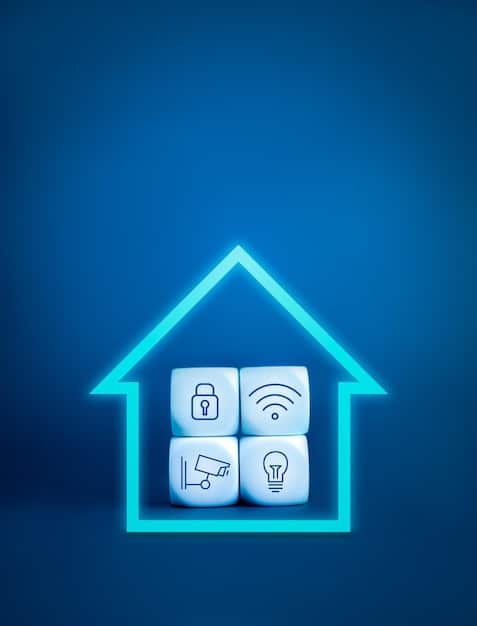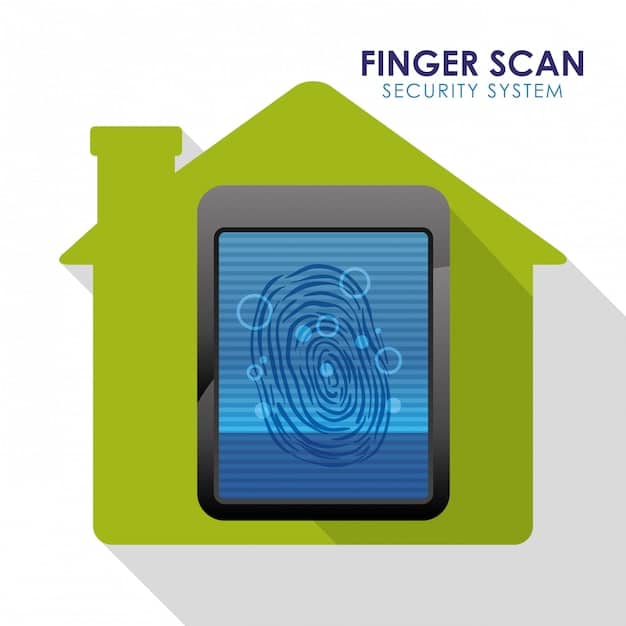Smart Home Cybersecurity: Protecting Your Devices by 2025

Anúncios
Navigating the ever-evolving landscape of smart home technology requires a proactive approach to cybersecurity, as safeguarding devices from potential cyber threats in 2025 is paramount for user privacy and system integrity.
As our homes become increasingly connected, the convenience of smart devices brings a parallel rise in cybersecurity concerns. Protecting your smart home isn’t just about convenience; it’s about safeguarding your privacy, data, and peace of mind from evolving digital threats. This guide delves into the essential strategies for fortifying your Smart Home Cybersecurity: Protecting Your Devices from Hackers in 2025.
Understanding the Current Smart Home Threat Landscape
In 2025, the proliferation of smart home devices has created an expansive network of potential entry points for malicious actors. From smart thermostats to smart door locks, each connected gadget represents a node in your personal ecosystem that, if unsecured, can expose sensitive data or even compromise physical security. Cybercriminals are constantly adapting their methods, targeting vulnerabilities ranging from weak default passwords to unpatched software flaws, making an informed and proactive defense essential.
Evolving Cyber Threats Targeting Smart Homes
The ingenuity of cybercriminals in exploiting emerging technologies means that the threats to smart homes are far more sophisticated than simple malware. We’re seeing an increase in highly targeted phishing campaigns designed to trick users into revealing login credentials for their smart home platforms. Beyond credentials, vulnerabilities in device firmware can be exploited to gain backdoor access, allowing attackers to manipulate devices, monitor activities, or even launch further attacks on other networks.
- Ransomware on IoT Devices: Devices might be locked or their data encrypted until a ransom is paid.
- Data Exfiltration: Sensitive information, like schedules, routines, or even video feeds, can be stolen.
- Physical Security Breaches: Compromised smart locks or cameras can directly endanger occupants.
- Botnet Recruitment: Vulnerable devices can be conscripted into large botnets for DDoS attacks.
The interconnected nature of smart home systems means a breach in one device can have cascading effects. An unsecured camera, for example, might not only expose private moments but could also be used as a pivot point to access your home network, potentially giving attackers control over other devices or access to personal files on connected computers. This interconnectedness underscores the importance of a holistic cybersecurity strategy rather than focusing on individual device protection in isolation.
Furthermore, the rapid pace of innovation in smart home technology often outstrips the development of robust security protocols. Many manufacturers prioritize functionality and ease of use over stringent security measures, leaving consumers with devices that, while convenient, may have inherent weaknesses. It’s an ongoing challenge to balance technological advancement with comprehensive security, a balance that consumers often have to manage themselves through diligent maintenance and informed choices.
Establishing a Robust Network Foundation for Your Smart Home
The underlying network infrastructure is the first and most critical line of defense for your smart home. A well-secured home network acts as a crucial barrier, preventing unauthorized access to your devices and data. In 2025, this means moving beyond basic Wi-Fi passwords to implementing more complex and layered security protocols that can withstand increasingly sophisticated cyberattacks. Your router, essentially the gatekeeper of your digital home, requires meticulous configuration and ongoing monitoring to ensure its integrity.
Securing Your Router and Wi-Fi Network
Your router’s default settings are often the weakest link. Changing the default administrative username and password immediately upon installation is non-negotiable. Opt for strong, unique passwords that combine uppercase and lowercase letters, numbers, and symbols. Beyond credentials, ensure your router’s firmware is always up to date. Manufacturers frequently release updates that patch newly discovered vulnerabilities, making firmware updates a fundamental aspect of network hygiene. Ignoring these updates leaves well-known backdoors open for exploitation.
- Strong, Unique Passwords: Change default router credentials and use WPA3 encryption if available.
- Firmware Updates: Regularly check for and install router firmware updates from the manufacturer’s website.
- Firewall Configuration: Enable and properly configure your router’s built-in firewall to restrict unwanted traffic.

Implementing a separate guest Wi-Fi network is another crucial step. This isolates your smart devices, computers, and other sensitive hardware from guests’ devices, reducing the risk of a breach through their potentially compromised hardware. By segmenting your network, you create a buffer that can contain any potential threat, preventing it from spreading to your core smart home devices.
Consider the use of a Virtual Private Network (VPN) at the router level if possible. A router-level VPN encrypts all traffic passing through your network, adding an extra layer of security and privacy for every device connected, from your smart doorbell to your voice assistant. While implementing a router VPN might require a bit more technical know-how, the enhanced security, particularly against eavesdropping and data interception, is invaluable in today’s threat landscape.
Finally, disabling Universal Plug and Play (UPnP) on your router is highly recommended. While UPnP simplifies device discovery and connection, it can also create security holes by allowing devices to automatically open ports without your explicit permission. For smart home devices that require specific port forwarding, configure these manually, ensuring only necessary ports are open and only for trusted devices.
Device-Specific Security Measures and Best Practices
Beyond the network, each smart device in your home requires individual attention to security. The sheer variety of gadgets, from smart bulbs to sophisticated security cameras, means a one-size-fits-all approach is insufficient. Effective smart home cybersecurity demands a granular focus on device-specific vulnerabilities and a commitment to ongoing maintenance. Ignoring device-level security is akin to locking your front door but leaving a window wide open.
Securing Individual Smart Devices
The first and most critical step for any new smart device is to change its default password. Default credentials are widely known and are often the first thing hackers try. Opt for strong, unique passwords for each device, avoiding patterns or easily guessable sequences. Utilize a password manager to keep track of these complex credentials without resorting to insecure habits like writing them down or reusing them across multiple services.
Regularly check for and install firmware updates. Just like your router, smart devices receive updates that address security vulnerabilities. Enable automatic updates whenever possible, or make it a routine to manually check for them. Outdated firmware is a prime target for exploits, as attackers can leverage known flaws that have already been patched by the manufacturer. Staying current is a foundational element of device security.
- Unique, Strong Passwords: Never use default passwords; create a distinct, complex password for each device.
- Frequent Firmware Updates: Keep device software up-to-date to patch vulnerabilities.
- Disable Unnecessary Features: Turn off features like remote access or UPnP if not actively used.
- Two-Factor Authentication (2FA): Enable 2FA on all smart home apps and platforms that support it.
Limiting remote access features is another wise precaution. While convenient, allowing external access to your devices can introduce risk. If remote access is essential, ensure it is protected by strong authentication. Additionally, consider whether every smart device truly needs internet access. Devices that primarily function locally, such as some smart plugs or light switches, might not require constant cloud connectivity, reducing their attack surface if kept offline when not needed.
Furthermore, be highly selective about the permissions you grant to smart home apps. Many apps request access to contacts, location, or microphone data that might not be necessary for their core function. Carefully review these permissions during setup and restrict them to only what is absolutely essential. Over-permissioning can lead to unnecessary data collection and potential privacy breaches if the app or its servers are compromised.
Finally, when disposing of or selling smart devices, perform a factory reset. This ensures all personal data, configurations, and network credentials are wiped, preventing future owners from accessing your information. Simply deleting an app or unpairing a device is often insufficient; a full reset is crucial for protecting your privacy post-ownership.
Leveraging Advanced Cybersecurity Tools and Practices
As smart home ecosystems grow in complexity, relying solely on basic security measures is no longer adequate. In 2025, advanced cybersecurity tools and practices are becoming essential components of a robust defense strategy. These tools provide an additional layer of protection, detecting and mitigating threats that might slip past more conventional defenses, offering peace of mind to the informed user.
Implementing a Zero-Trust Approach at Home
A “zero-trust” model, traditionally applied in corporate environments, is increasingly relevant for smart homes. This approach dictates that no device or user, whether inside or outside the network, automatically gains trust. Instead, every access request must be verified. For a smart home, this translates to micro-segmentation of your network, creating isolated segments for different device types (e.g., IoT devices, computers, guests).
Deploying specialized IoT security solutions, often available as add-ons to routers or as standalone hardware, can monitor traffic patterns for anomalies, identify unauthorized access attempts, and even quarantine suspicious devices. These solutions often use artificial intelligence and machine learning to learn normal device behavior, making them highly effective at detecting unusual activity that could indicate a breach. This proactive monitoring can alert you to threats before they cause significant damage.
- Network Segmentation: Create separate VLANs or guest networks for smart devices to isolate them from sensitive data.
- IoT Security Appliances: Invest in dedicated devices that monitor and protect smart home traffic.
- Regular Security Audits: Periodically scan your network for vulnerabilities and exposed devices.
The importance of regular security audits cannot be overstated. Utilize network scanners or home security analysis tools to identify open ports, weak passwords, and vulnerable devices on your network. Many advanced routers or third-party cybersecurity software offers these capabilities. Treating your home network like a mini-enterprise network, subject to periodic security reviews, helps ensure that hidden vulnerabilities are uncovered and addressed before they can be exploited.
Consider employing DNS filtering services. These services can block access to known malicious websites and command-and-control servers, preventing your smart devices from communicating with hacker infrastructure even if they become compromised. This acts as an additional layer of defense against malware and phishing attempts, adding an intelligent filter at the internet gateway.

Finally, understand the power of logging and alerting. Many smart devices and routers offer the ability to log connection attempts and unusual activities. While reviewing these logs can be daunting, setting up alerts for critical events (e.g., failed login attempts, unusual data transfers) can provide immediate notification of potential security incidents, allowing for rapid response and mitigation.
Educating Your Household and Maintaining Vigilance
Technology alone cannot guarantee absolute security. The human element often remains the weakest link in any cybersecurity chain. For a smart home, ensuring that every member of your household understands basic security hygiene is paramount. In 2025, vigilance and ongoing education are as crucial as any technical safeguard, fostering a culture of cybersecurity awareness within your home.
Cultivating a Security-Conscious Environment
Start by educating everyone in the household on the importance of strong, unique passwords for all accounts, not just smart home devices. Explain the dangers of phishing emails, suspicious links, and unverified app downloads. Encourage a skeptical mindset towards unsolicited communications, reinforcing the idea that if something looks too good to be true, it probably is. Regular, gentle reminders about these practices can embed good habits over time.
Discuss the privacy implications of smart home devices. Explain how voice assistants process commands, how cameras capture footage, and how smart speakers might be always listening. This transparency helps household members understand why certain security measures are in place and encourages more responsible interaction with the technology. Understanding “why” often leads to better adherence to security protocols.
- Password Hygiene: Teach family members to use strong, unique passwords and password managers.
- Phishing Awareness: Educate on identifying and avoiding phishing attempts via email, text, or calls.
- Data Privacy Discussions: Explain how devices collect data and the importance of privacy settings.
Establishing clear rules for adding new devices to the network is also vital. Encourage family members to consult with the primary smart home administrator before purchasing and connecting new gadgets. This allows for proper vetting of device security features, ensuring that only reputable brands with strong privacy assurances are integrated into the home ecosystem, preventing the introduction of rogue or insecure devices.
Furthermore, conduct regular “security refreshers” as a family. This doesn’t need to be a formal lecture but could involve discussing recent smart home security news, new threats, or updated best practices. Keeping conversations about cybersecurity ongoing and informal can help demystify the topic and keep everyone engaged in maintaining a secure living environment.
Finally, have a clear incident response plan. What happens if a device is compromised? Who is responsible for disconnecting it, changing passwords, and notifying necessary parties? Having a predefined plan, even a simple one, can significantly reduce the impact and stress of a security incident, allowing for a quicker and more effective recovery.
The Future of Smart Home Cybersecurity Beyond 2025
Looking beyond 2025, the landscape of smart home cybersecurity is poised for significant transformation, driven by advancements in artificial intelligence, blockchain, and new regulatory frameworks. The increasing connectivity and autonomy of smart devices will necessitate even more sophisticated protective measures, shifting some of the burden from the consumer to the manufacturers and service providers.
Emerging Technologies and AI-Driven Security
Artificial intelligence will play an even more dominant role in proactive threat detection and response. AI-powered security systems will be capable of learning complex behavioral patterns of smart devices and users, instantly flagging deviations that indicate a compromise. Imagine a system that recognizes an unusual surge in data from your smart refrigerator or an unauthorized attempt to access your smart thermostat, automatically isolating the device before any widespread damage occurs. Such systems will move beyond signature-based detection to predict and prevent zero-day attacks.
The integration of blockchain technology could revolutionize device authentication and data integrity. Decentralized ledgers could provide tamper-proof records of device identities and firmware versions, making it incredibly difficult for attackers to spoof devices or inject malicious updates. This distributed trust mechanism could offer a level of security previously unattainable for fragmented smart home ecosystems.
- AI-Powered Anomaly Detection: Real-time identification of unusual device behavior.
- Blockchain for Device Identity: Secure, immutable records for device authentication.
- Hardware-Based Security: More robust security chips embedded directly into devices.
As the smart home becomes an integral part of broader smart city infrastructures, regulatory oversight will likely increase. Governments and industry bodies may establish stricter mandates for IoT security, similar to how cybersecurity is regulated in critical infrastructure sectors. This could lead to standardized security certifications, mandatory minimum security requirements, and greater accountability for manufacturers, ensuring a baseline level of protection for all connected devices sold to consumers.
New authentication methods are also on the horizon. Beyond biometric authentication, expect to see more context-aware security layers, where access is granted not just based on who you are, but also where you are, what device you’re using, and even your typical behavioral patterns. This multi-layered, adaptive authentication will provide a more fluid yet robust security experience.
Ultimately, the future points towards a more symbiotic relationship between devices, networks, and advanced security frameworks. Consumers will still need to practice vigilance, but the tools and infrastructure supporting their efforts will be far more intelligent and autonomous, aiming to detect and neutralize threats with minimal human intervention. This evolution will be critical in building truly resilient and trustworthy smart home environments.
Incident Response and Recovery Strategies
Even with the most robust preventative measures, a security incident can occur. A well-defined incident response and recovery strategy is crucial for minimizing damage, restoring functionality, and preventing recurrence. In 2025, preparing for the inevitable means having a clear plan of action that encompasses detection, containment, eradication, and post-incident analysis for your smart home.
Responding to a Smart Home Breach
The first step in any incident is rapid detection. Monitor for unusual activity: devices behaving erratically, unexpected data usage, new unknown devices on your network, or suspicious notifications from smart home apps. Setting up alerts for critical events, if your devices or router allow, can provide early warning. Quick detection is key to limiting the scope of any potential damage.
Once an anomaly is detected, the priority shifts to containment. Immediately disconnect the compromised device from your network – physically unplug it, or if that’s not feasible, disable its Wi-Fi access through your router. This isolates the threat, preventing it from spreading to other devices or serving as a base for further attacks. Change passwords for any affected devices and any linked accounts immediately.
- Detect Anomalies Early: Monitor device behavior, network traffic, and app notifications for irregularities.
- Isolate Compromised Devices: Disconnect or disable internet access for suspicious devices immediately.
- Change All Related Passwords: Update credentials for affected devices, linked accounts, and network if necessary.
Eradication involves removing the threat entirely. This typically means performing a factory reset on the compromised device and then reinstalling its firmware. Only reconnect the device to your network after its security has been thoroughly reviewed and all known vulnerabilities addressed. If the breach involved a specific app, delete and reinstall it after changing associated passwords.
Recovery is the process of restoring your smart home to its normal, secure state. This includes reconfiguring devices with new, strong passwords, updating all firmware, and re-enabling any services that were temporarily disabled. It’s also an opportune time to review and strengthen existing security measures, such as enabling two-factor authentication on more accounts or segmenting your network further.
Finally, always conduct a post-incident analysis. What happened? How did the breach occur? What lessons can be learned? This analysis helps identify weaknesses in your security posture and refine your future preventative measures, turning a negative event into a valuable learning experience. Documenting the incident can also be helpful for future reference or if you need to report the incident to authorities or device manufacturers.
| Key Area | Brief Description |
|---|---|
| 🔒 Network Foundation | Secure router with strong passwords, WPA3, and regular firmware updates. Utilize separate guest Wi-Fi. |
| 📱 Device Security | Change default passwords, enable 2FA, and keep device firmware updated. Disable unnecessary features. |
| 🛠️ Advanced Tools | Implement network segmentation, IoT security solutions, and conduct regular security audits. |
| 👨👩👧👦 User Awareness | Educate household on password hygiene, phishing, and data privacy. Establish clear device rules. |
Frequently Asked Questions About Smart Home Cybersecurity
Standard Wi-Fi encryption primarily secures the connection between your device and router. Smart home devices often have additional vulnerabilities such as weak default passwords, open ports, or outdated firmware that attackers can exploit directly, even if your Wi-Fi is encrypted. A multi-layered approach is essential.
Yes, creating a separate network (like a guest Wi-Fi or a dedicated IoT VLAN) for your smart devices is highly recommended. This isolates them from your main network where sensitive data (e.g., computers, financial information) resides, limiting potential damage if a smart device is compromised.
You should update firmware as soon as updates are available. Manufacturers frequently release patches for newly discovered security vulnerabilities. For best practice, enable automatic updates if the option exists, or make it a weekly or bi-weekly routine to check manually.
Two-factor authentication (2FA) adds an extra layer of security by requiring a second verification method (e.g., a code from your phone) in addition to your password. This means even if a hacker obtains your password, they still cannot access your account without that second factor, significantly increasing security.
Potentially, yes. If smart cameras, microphones, or even smart TVs are compromised, unauthorized individuals could gain access to video feeds or audio recordings. This underscores the critical need for strong passwords, up-to-date firmware, and careful permission management for all smart devices.
Conclusion
As we navigate the increasingly interconnected world of 2025, robust smart home cybersecurity is not merely an optional upgrade but a fundamental necessity. Protecting your devices from hackers demands a layered approach: securing your network, diligently managing individual device vulnerabilities, leveraging advanced security tools, and, critically, fostering a security-aware household. While the digital threat landscape continues to evolve, proactive measures, ongoing vigilance, and an informed strategy empower you to enjoy the convenience of smart living without compromising your privacy or peace of mind.





